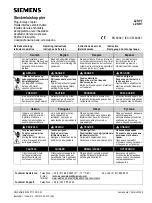
109
6
F
2
S
0
8
3
4
Element Range
Step Default Remarks
TCDT2
−
10000 – 10000
1
µ
s 0
µ
s
Transmission delay time difference setting
for channel 2 (*1)
(*1) This setting is only used when there is a fixed difference between the sending and receiving
transmission delay time. When the delay times are equal, the default setting of 0
µ
s must be used.
(*2) If the channel delay time of CH1 or CH2 exceeds the TDSV setting, then the alarm "Td1 over" or
"Td2 over" is given respectively.
CO. LINK:
To set Integral digital communication or External communication.
SP. SYN:
One of terminals must be set to MASTER and others SLAVE. If not, the synchronized
sampling fails.
Note: As the simultaneous setting change at all terminals is not practical, it is not recommended to
change the settings when the relay is in service.
TERM:
To set two-terminal or three-terminal application.
CH. USE:
Set the using channel CH1 or CH2 when the chain topology is applied.
CH.CON:
In case of the two-terminal line application, the communication ports of the GRZ100
are interlinked with port CH1 as shown in Figure 2.5.1.9(a) and (b). In case of three-terminal
application, port CH1 of one terminal and port CH2 of the other terminal are linked as shown in
Figure 2.5.1.9(c). In these normal linkages, the communication port exchange switch [CH.CON]
is set to "Normal".
T.SFT1, T.SFT2:
The T.SFT1 and T.SFT2 are used to synchronize the relay with the multiplexer
by shifting the send signal by a half-bit when the distance from the relay to the multiplexer is long.
When electrical interface X.21, CCITT G.703-1.2.2 or -1.2.3 is applied and the distance (cable
length from relay to multiplexer) is 300m or more, the setting is set to "ON"
B.SYN1, B.SYN2:
The B.SYN1 and B.SYN2 are set to "ON" when the relay is linked via
multiplexer, and set to "OFF" when direct link is applied.
This setting is available for CCITT G.703-1.2.1, 1.2.2, 1.2.3, X21 and optical interface (short
distance: 2km class). In the case of optical interface 30km and 80km class, this setting is
neglected.
TDSV:
The TDSV is a transmission delay time threshold setting. GRZ100 gives an alarm if the
transmission delay time exceeds TDSV. The alarm messages are "Td1 over" for CH1 and "Td2
over" for CH2.
TCDT1, TCDT2:
The TCDT1 and TCDT2 are transmission time delay difference settings for
CH1 and CH2 respectively. If there is a permanent and constant difference of more than 100
µ
s
between the send and receive channel delay times, then the TCDT setting is used to compensate
for that difference. The setting is calculated as follows:
TCDT
∗
= (Sending delay time)
−
(Receiving delay time)
(Example)
RELAY A
RELAY B
RELAY C
CH1
CH1
CH1
CH2
CH2
CH2
1000
µ
s
1000
µ
s
2000
µ
s
1000
µ
s
3000
µ
s
5000
µ
s
CH1: TCDT1 = 2000
−
1000
= 1000
µ
s
CH2: TCDT2 = 1000
−
1000
= 0
µ
s
CH1: TCDT1 = 5000
−
3000
= 2000
µ
s
CH2: TCDT2 = 1000
−
2000
=
−
1000
µ
s
CH1: TCDT1 = 1000
−
1000
= 0
µ
s
CH2: TCDT2 = 3000
−
5000
=
−
2000
µ
s
www
. ElectricalPartManuals
. com
Summary of Contents for GRZ100-211B
Page 323: ... 322 6 F 2 S 0 8 3 4 w w w E l e c t r i c a l P a r t M a n u a l s c o m ...
Page 343: ... 342 6 F 2 S 0 8 3 4 w w w E l e c t r i c a l P a r t M a n u a l s c o m ...
Page 383: ... 382 6 F 2 S 0 8 3 4 w w w E l e c t r i c a l P a r t M a n u a l s c o m ...
Page 395: ... 394 6 F 2 S 0 8 3 4 w w w E l e c t r i c a l P a r t M a n u a l s c o m ...
Page 411: ... 410 6 F 2 S 0 8 3 4 w w w E l e c t r i c a l P a r t M a n u a l s c o m ...
Page 423: ... 422 6 F 2 S 0 8 3 4 w w w E l e c t r i c a l P a r t M a n u a l s c o m ...
Page 443: ... 442 6 F 2 S 0 8 3 4 w w w E l e c t r i c a l P a r t M a n u a l s c o m ...
Page 451: ... 450 6 F 2 S 0 8 3 4 w w w E l e c t r i c a l P a r t M a n u a l s c o m ...
Page 459: ... 458 6 F 2 S 0 8 3 4 w w w E l e c t r i c a l P a r t M a n u a l s c o m ...
Page 463: ...w w w E l e c t r i c a l P a r t M a n u a l s c o m ...
















































